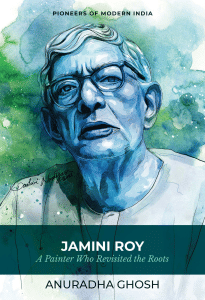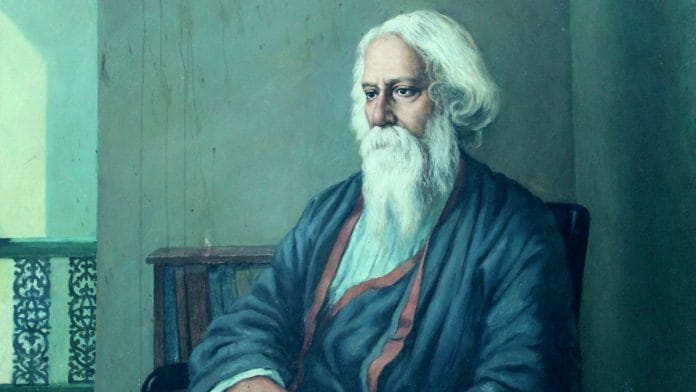There was a separate room in which Roy’s collection of traditional Bengal pats were on display as well. This close approximation to a slice of rural Bengal within a busy North Calcutta lane was an interesting interface of the imaginary and the real, the awareness of each state mediating with the other and bringing into the equation the inevitable strands of nostalgia and longing for the non-present. In fact, different kinds of co-presences have characterised Jamini Roy’s works almost always: the present attends the past, the urban negotiates with the rural.
Rabindranath Tagore had come to visit Roy and see his paintings at his home: it is said that he sat waiting on a chowki for Jamini Roy, who was then out shopping for the marriage of his eldest daughter. On his return, he saw a sizeable crowd in his lane who had gathered to see the poet but Roy had no idea that it was his house that the poet was in! It is also said that Tagore wanted him to join Santiniketan, but Roy refused, perhaps anticipating a stunt of artistic growth that might come about under the shadow of a creative giant. In fact, Roy is known to have asked Tagore to ‘abandon Santiniketan, stop being ‘Gurudeva’ and devote himself solely to painting.’ Roy was fascinated by Tagore’s paintings, especially what he called the ‘lively, spirited backbone’ that differentiated his work from all else. Tagore’s letters (written during the final months of his life) to Roy indicate that the poet, too, greatly valued this appreciation: in one of these letters (dated 25 May 1941), he says, ‘this evidence, from someone as talented as you, is a matter of great assurance to me.’
The 1937 show of Roy’s works at the gallery of Indian Society of Oriental Art at Samabay Mansion unequivocally established his growing fame. This exhibition remained memorable for him chiefly for the hearty appreciation he received from Gaganendranath Tagore, who had also purchased Roy’s Mother and Child. Gaganendranath was considerably ill at the time of this exhibition and had lost his power of speech due to paralysis. He came to see the exhibition nevertheless, and was so overwhelmed with the works that he embraced the artist with his face awash with flowing tears. Roy was to recount this experience many a time later in his life (it acquired a deeper and more poignant dimension especially because Gaganendranath passed away the year after) and remembered the veteran artist’s reaction as a kind of blessing: ‘He praised my work with his tears, communicated to me the words of his heart— how much love and affection he had for me.’
Soon afterwards, in 1938, he had another notable exhibition at sculptor Kshitish Chandra Roy’s studio at British Indian Street. These two significant back-to-back shows did considerably extend his reputation; they also consolidated his connections with the noted intellectuals of Calcutta, many of whom were from the West and adored his work. Prominent among them were Lindsay Emerson, the British assistant editor of The Statesman, his Bengali wife Mrinalini Emerson, Maie Casey (wife of the last Lieutenant Governor of Bengal) John Irwin and Mary Milford. Milford, in a reminiscence on the artist that she published in 1944 in London, recalled how the artist would paint all day, propped by a bolster, surrounded by earthen pots of bright colours. In his house, as she remembered, his works were hung in three rooms, each room devoted to a different style: the first room had his earlier Kalighat- inspired works, the second displayed his experiments with the French impressionistic mode (ref. pic 15), and also some pointillist landscapes in bright primary colours (it is interesting to note that the early portraits, which he had become renowned for, went unrepresented in this display). The third room was for his major works in the folk idiom, steeped in mythology. Roy was also visited at his home by illustrious guests such as the British biologist J.B.S Haldane, novelist E.M. Forster and the Soviet film director Vsevolod Pudovkin. An interesting anecdote describes how both Pudovkin and actor Nikolai Cherkasov (the two were co-actors in Eisenstein’s Ivan the Terrible) wanted to buy the same Roy painting, of a blue-veiled woman. Cherkasov had to be content with another almost similar painting, as Pudovkin had chosen first. Both were happy: they felt as if the two painted women were sisters, one would go to Moscow with the director, and the other would accompany the actor to Leningrad!
Also Read: Yoga and Kama are not said in same breath in India today. But it should
We do not know whether it was the cultural difference that provided an extra dimension of fascination to his overseas admirers, or whether Roy’s works provided to them a welcome change from the pan-Indian phenomenon of painting in the fashion of Western modernists. Rolf Italiaander, the German writer and director (who called Roy the ‘Great Master’) was pained to see in the 32nd Exhibition of All India Fine Arts and Crafts Society (AIFACS) ‘only ten percent of Indian motifs’, amid artworks mostly following European stylistics, both old and new. It is understandable, thus, how the indigenous vein of Roy’s paintings would be especially impressive to those who were already overtly familiar with what was happening in the West–Indian paintings following the Western idiom hardly had any fresh appeal for them. During the Second World War, the much-debated book of novelist Beverley Nichols, Verdict on India, proclaimed that there was ‘only one artist of any consequence, by name Jamini Roy’ while ‘India was an artistic desert…the artist was on the level with the untouchable.’
 This excerpt from ‘Jamini Roy: A Painter Who Revisited the Roots’ by Anuradha Ghosh has been published with permission from Niyogi Books.
This excerpt from ‘Jamini Roy: A Painter Who Revisited the Roots’ by Anuradha Ghosh has been published with permission from Niyogi Books.






